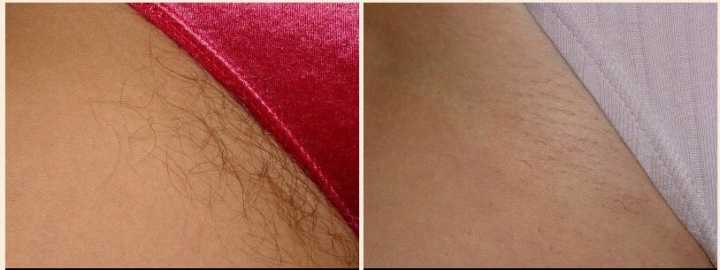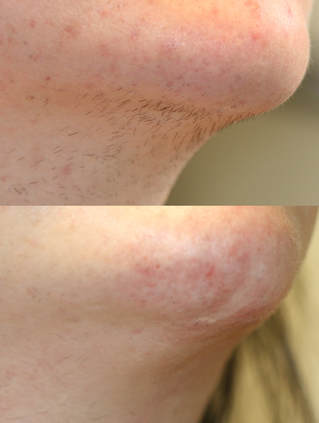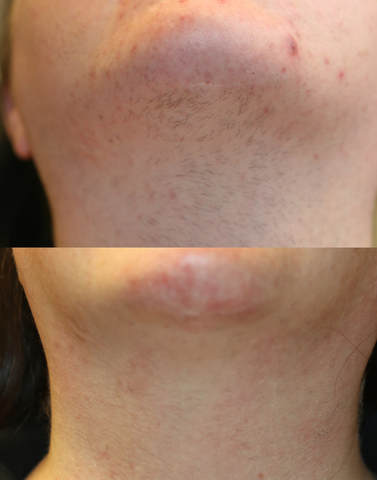What is laser hair removal best for?
Laser hair removal is most commonly used for unwanted hair in the following places:
It still does not work well for grey hair, fine blond hair, or women with hormonal problems such as polycystic ovaries disease. Also, if you just have a few, coarse hairs on your chin, a good electrolysist will be more cost effective.
- the face
- the armpits and bikini line
- legs
- forearms
It still does not work well for grey hair, fine blond hair, or women with hormonal problems such as polycystic ovaries disease. Also, if you just have a few, coarse hairs on your chin, a good electrolysist will be more cost effective.
how does laser hair removal work?
|
The laser emits a very specific beam of light at a wavelength that is targeted at melanin in the hair and/or at the follicle growth center (called the hair bulb). Melanin is the material that gives color to our hair and skin. The laser beam passes through the skin and is absorbed by the melanin in the hair follicle.
Therefore, the ideal candidate for this procedure has hair that is darker than her skin color. If the skin and hair color are too similar, it confuses some lasers. Darker skin needs “long-wave” hair-removal lasers like the YAG laser. They are safer if you have darker skin because they won’t “burn” the skin trying to get rid of the hair. |
why do i need a series of treatments
|
At any given time, a certain percentage of hairs are in the “resting” phase, rather than a growth phase. The laser will not be effective on those resting hairs, which is why, on average, five treatments are necessary in each area to achieve maximum results.
More treatments can be done as soon as further hair growth appears. Due to the variation in the number of hairs in the resting phase, certain parts of the body will respond more rapidly whereas others might take much longer to show effects. For example, the face usually responds more slowly than the bikini line. |
how much does laser hair removal cost
|
A single treatment of the lip and chin area costs around $200-400, with a series of 5 costing about $1,000-2,000 depending on how much hair there is.
But remember that single treatments will not be effective. You need a series of about 5 treatments in order to reach all hairs in their various growth phases. A single treatment of the bikini or the underarm is about $200-400, with a series of 5 treatments costing about $1,000-2,000 depending on how much hair and whether the upper thighs are included. Larger areas like a back cost more. Maintenance treatments are usually less expensive. |
do treatments hurt and how long will they take
|
There may be mild discomfort during the treatment, but most patients tolerate laser hair removal very easily.
For discomfort during your treatment, we will provide you with a topical numbing cream which you can apply before a treatment. If you are using the cream yourself, never apply numbing cream under saran wrap and never apply it to to an area larger than your hand. We also use a cooling machine (Zimmer cooler) during the treatment to make the experience more comfortable. Treatments can take from minutes to hours, depending on the size of the treatment area. |
How many treatments will it take
|
After three to seven treatments initially, most women and men report that their expectations have been met and the hair growth pattern is much, much less. In some areas, in addition to the decrease in the number of hairs, the hairs become very fine and light in color.
All hairs will NEVER be permanently eradicated. Most patients will need a touch-up 1-4 times a year to maintain the improvement. Expect to need more treatments if you have any history of irregular periods, polycystic ovary disease, gray or white hairs, or a family history of excessive hair. About 5 percent of patients are resistant to any type of hair removal laser. It is very important to have a realistic expectation regarding individual results of hair removal. No hair-removal system anywhere is “permanent.” |
"Well, the last time I had a picture taken I could hardly see my eyes because of the weight of heavy eyelid. Then I paid attention to how I was actually using my eyes and I really noticed when I was looking at anything especially the computer I was straining my forehead to see better. Since I have had it done I no longer have to lift the forehead and tilt my head to see. It is amazing! I love..." D. Rock 63 Yrs Old with Fat Droopy Eyes - Salt Lake City, UT
do i need to do anything special before being treated
|
1. Do not tan. Tanning of any type changes the laser settings and is the most common cause of blistering after laser hair removal. Do not use self-tanners one to two weeks before a treatment.
2. No plucking, electrolysis, bleaching or depilatories should be performed at least two weeks prior to treatment. The hair must be present, a short stubble, and with its natural hair color in order to be treated effectively. 3. No waxing for the two weeks leading to your treatment. 4. Shaving is fine up until a few days before your treatment. 5. All makeup and lotion should be removed prior to treatment. 6. If antibiotics or any new medications have been started, inform us prior to treatment. 7. For bikini line hair removal, wear light-colored clothes because the laser is absorbed by dark |
When is hair removal more difficult
|
1. If you have hormonal abnormalities like irregular periods or polycystic ovaries
2. If your hair is blonde or white 3. If it’s hard for you to make the time for an initial series of five or six monthly appointments 4. If you have darker hair and darker skin, go to a center that has lasers specifically designed for you, such as the Nd:Yag 5. If you can’t get yourself to stop tanning |
what are the medial or cosmetic side effects?
1. Pain. Some people feel discomfort during the treatment. There may be a burning sensation, which lasts for an hour or two.
2. Healing. There is always a slight possibility of developing a crust or blister. This is superficial and generally does not result in any scarring and is treated like a sunburn or any other superficial blister.
3. Pigment changes. The treated area will probably heal without any pigment changes; however, there is always a chance that darker or lighter areas may occur. These are usually temporary and will fade within 1-6 months. Sun exposure must be avoided if a darker spot occurs, as that may intensify the hyperpigmentation. It is rare that a change is permanent.
4. Scarring is very rare and it is important to follow all the post- treatment instructions carefully.
5. Swelling may occur immediately after treatment, especially on the face. This is temporary and not harmful.
6. Fragile skin. Skin that has been treated should be cared for gently for several days. It should not be rubbed.
7. Bruising is rare. It will generally clear up within 4-10 days.
2. Healing. There is always a slight possibility of developing a crust or blister. This is superficial and generally does not result in any scarring and is treated like a sunburn or any other superficial blister.
3. Pigment changes. The treated area will probably heal without any pigment changes; however, there is always a chance that darker or lighter areas may occur. These are usually temporary and will fade within 1-6 months. Sun exposure must be avoided if a darker spot occurs, as that may intensify the hyperpigmentation. It is rare that a change is permanent.
4. Scarring is very rare and it is important to follow all the post- treatment instructions carefully.
5. Swelling may occur immediately after treatment, especially on the face. This is temporary and not harmful.
6. Fragile skin. Skin that has been treated should be cared for gently for several days. It should not be rubbed.
7. Bruising is rare. It will generally clear up within 4-10 days.
"I had a excellent eye lift done by Dr. Patel. He knows what he is doing and is very pleasant. Dr.Patel was easy to get an appointment and he works with you. The office staff was very pleasant and made you feel calm." D. Gull Highly recommended for eye lift surgery - Salt Lake City, UT
Laser hair removal video
Schedule Your Consult Today |
Find UsLocations:
Dr. BCK Patel MD, FRCS 1025E 3300S Salt Lake City, Utah 84106, USA (801) 413-3599 (phone/text) E: [email protected] bckpatel.info Dr. BCK Patel MD, FRCS 585 E Riverside Dr Suite 201 Saint George, UT 84790 (435) 215-0014 E: [email protected] Quick-Link |
Let Us answer your questions |















